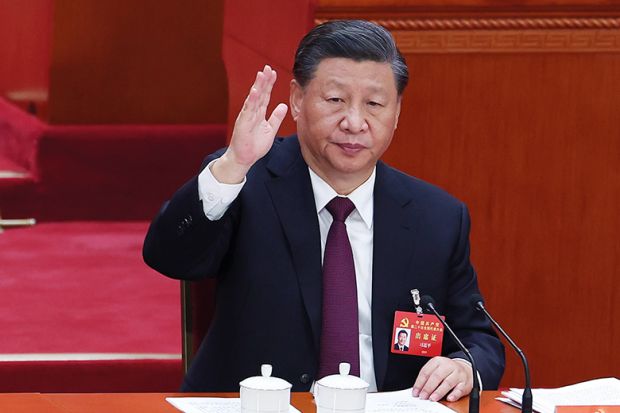International coverage of the Communist Party of China’s National Congress has largely focused on the confirmation that Xi Jinping will serve a third five-year term in office and what this means for the country’s 1.4 billion citizens.
But the twice-a-decade conference, which ended on 22 October, has also been a momentous one for universities – with the strategic importance of education, especially higher education, to modern Chinese socialism stressed more than ever by General Secretary Xi.
Previous national congresses have certainly articulated the central role of education in improving people’s well-being and quality of life. But this congress went much further. This time, according to the report delivered by Xi to the 20th National Congress, education, science and technology, and human resources are the central planks of the plan to invigorate the country through science and education. Nothing less than the future of the party and nation depends upon the success of educational advancement.
In essence, China’s vision is that supporting graduate talent will drive scientific and technological innovation, leading to improvements in national innovation capability and productivity. Without a well-funded, world-class education system, it is impossible to achieve this aim. But modernisation is also part of the plan and the National Congress report suggests China’s universities can expect significant changes in coming years.
But the report goes further. In past reports of the party congress, supporting science and technology was generally linked to economic development and improving human capital, while education matters were generally linked to issues around people’s livelihood and well-being. This time, all these strands are tightly interwoven, with our leader insisting that socialist education, better science and stronger graduates can support each other.
The report requires all party members to fully recognise the fundamental importance of universal education and support for teaching at all ages, and in all types of educational institutions. We need to develop education that meets the people’s expectations. But it also endows a special mission to China’s world-class universities, particularly those supported by the Double First-Class Initiative.
Policymakers and scholars acknowledge that universities are different: they are beacons of social progress and engines driving economic development, which shoulder the heavy responsibility of training top talent. Within this framework, universities are asked to bear the responsibility of Xi’s strategy of transforming China through science and education.
In practice, this means producing talented graduates, encouraging innovation-led economic growth, pursuing novel fields of inquiry, and supporting the overall efficiency of the national innovation system. As seen in some other advanced economies, universities will soon be tasked with providing much more innovation and entrepreneurship education to their already often-commercially minded students. China is eager to accelerate the transition to a model of innovative universities, as previously seen with guidelines issued in October 2021 on supporting college students with innovation and entrepreneurship.
Encouraging an entrepreneurial society is certainly not a new venture for Chinese universities but it will increasingly become a priority, with funding likely to follow those institutions whose graduates excel in this area.
Xi’s report underlines the central role that universities will play in the three strategies for invigorating China through science and education, skilling the workforce and driving innovation-led development. All three strategies place new demands on university staff. Colleges and universities will need to reform their innovation and entrepreneurship teaching and integrate innovation and entrepreneurship education into staff training.
Specific measures may include offering more theoretical and co-curricular courses, transforming teaching methods, strengthening the connection between course content and the real world, and fostering more spin-offs.
While global university rankings will still matter, new assessments of innovation and entrepreneurship education will also become important indicators for Chinese universities. Similar changes have already begun in India, where the government launched the Atal Ranking of Institutions on Innovation Achievement in December 2021, to promote the transformation of universities and the establishment of an academic innovation and entrepreneurship system. Similar frameworks could soon arrive in China.
Innovation will become increasingly central to China’s modernisation drive. In practice, it will mean mobilising resources nationwide to inspire greater creativity, investing more effectively in science and technology and advancing reform of the mechanisms for allocating government research funding. More incentives will be given to science strategists, first-class scientists and innovation teams, young scientists, outstanding engineers, master craftsmen and highly skilled workers.
Combining support for world-class research, outstanding innovation activity and educational equity will be difficult and expensive. It will also require each of us to take up the heavy responsibility of modernising education in Chinese style. By doing so, however, China can create a new era of socialist education at universities with distinctive Chinese characteristics.
Hao Ni is an associate professor attached to Zhejiang University’s Research Center for Regional Coordinated Development, and Zhejiang University’s Institute of State System Research.
Register to continue
Why register?
- Registration is free and only takes a moment
- Once registered, you can read 3 articles a month
- Sign up for our newsletter
Subscribe
Or subscribe for unlimited access to:
- Unlimited access to news, views, insights & reviews
- Digital editions
- Digital access to THE’s university and college rankings analysis
Already registered or a current subscriber? Login










